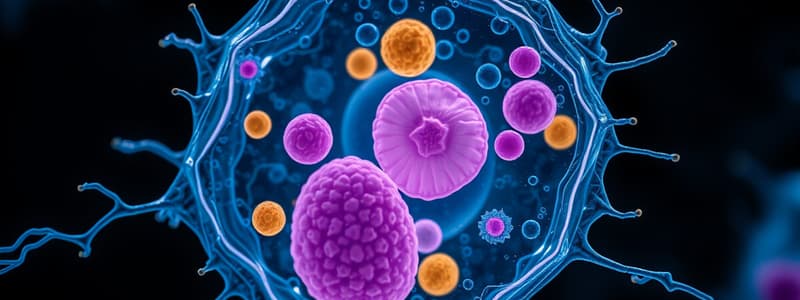Podcast
Questions and Answers
What is the function of the cell membrane?
What is the function of the cell membrane?
- To store nutrients
- To generate ATP
- To contain DNA
- To control the entry and exit of substances (correct)
What is an analogy for the cell membrane?
What is an analogy for the cell membrane?
The cell membrane is like an Oreo.
What is the function of the nucleus?
What is the function of the nucleus?
The control center of the cell that contains the DNA.
What is an analogy for the nucleus?
What is an analogy for the nucleus?
What are vesicles?
What are vesicles?
What is an analogy for vesicles?
What is an analogy for vesicles?
What is the function of vacuoles?
What is the function of vacuoles?
What is an analogy for vacuoles?
What is an analogy for vacuoles?
What is a central vacuole?
What is a central vacuole?
What is an analogy for the central vacuole?
What is an analogy for the central vacuole?
What do ribosomes do?
What do ribosomes do?
What is an analogy for ribosomes?
What is an analogy for ribosomes?
What are mitochondria known for?
What are mitochondria known for?
What is an analogy for mitochondria?
What is an analogy for mitochondria?
What does the Golgi body do?
What does the Golgi body do?
What is an analogy for the Golgi body?
What is an analogy for the Golgi body?
What is the rough endoplasmic reticulum?
What is the rough endoplasmic reticulum?
What is an analogy for the rough endoplasmic reticulum?
What is an analogy for the rough endoplasmic reticulum?
What do lysosomes do?
What do lysosomes do?
What is an analogy for lysosomes?
What is an analogy for lysosomes?
What are microtubules?
What are microtubules?
What is an analogy for microtubules?
What is an analogy for microtubules?
What is the function of chloroplasts?
What is the function of chloroplasts?
What are the major organelles that work together to create protein?
What are the major organelles that work together to create protein?
What are some similarities between eukaryotic and prokaryotic cells?
What are some similarities between eukaryotic and prokaryotic cells?
What are some differences between eukaryotic and prokaryotic cells?
What are some differences between eukaryotic and prokaryotic cells?
Flashcards
Cell Membrane
Cell Membrane
The outermost layer of a cell that acts as a barrier, controlling what enters and exits.
Nucleus
Nucleus
The control center of the cell, containing DNA that directs all cell activities.
Vesicles
Vesicles
Tiny sacs that transport proteins and other materials around the cell.
Vacuole
Vacuole
Signup and view all the flashcards
Central Vacuole
Central Vacuole
Signup and view all the flashcards
Ribosomes
Ribosomes
Signup and view all the flashcards
Mitochondria
Mitochondria
Signup and view all the flashcards
Golgi Body
Golgi Body
Signup and view all the flashcards
Rough Endoplasmic Reticulum (RER)
Rough Endoplasmic Reticulum (RER)
Signup and view all the flashcards
Lysosomes
Lysosomes
Signup and view all the flashcards
Microtubules
Microtubules
Signup and view all the flashcards
Chloroplast
Chloroplast
Signup and view all the flashcards
Protein Creation Process
Protein Creation Process
Signup and view all the flashcards
Eukaryotic Cells
Eukaryotic Cells
Signup and view all the flashcards
Prokaryotic Cells
Prokaryotic Cells
Signup and view all the flashcards
Study Notes
Cell Membrane
- All cells possess a cell membrane that protects the cell and regulates the passage of substances in and out.
- Acts as a barrier between the cell's interior and its external environment.
Nucleus
- Functions as the control center of the cell, housing DNA which directs cellular activities and functions.
Vesicles
- Small cellular structures that transport proteins and materials to the Golgi apparatus for modification and use by the cell.
Vacuole
- Sac-like structures within cells that store essential materials such as food and nutrients.
Central Vacuole
- A large vacuole typically found in plant cells primarily used for water storage and maintaining turgor pressure.
Ribosomes
- Synthesized in the nucleolus, ribosomes are crucial for protein production and can float freely in the cytoplasm or attach to the endoplasmic reticulum.
Mitochondria
- Known as the powerhouse of the cell, responsible for generating ATP, the energy currency that fuels cellular activities.
Golgi Body
- Modifies, sorts, and packages proteins and lipids received from the endoplasmic reticulum for secretion or delivery within the cell.
Rough Endoplasmic Reticulum (RER)
- Studded with ribosomes, the RER is involved in the synthesis and modification of proteins intended for export.
Lysosomes
- Enzyme-filled organelles that break down waste materials and damaged cellular components, acting as the cell's cleaning system.
Microtubules
- Protein structures that form part of the cytoskeleton, providing shape to the cell and assisting in the transport of organelles.
Chloroplast
- Organelles found in plant cells where photosynthesis occurs, capturing sunlight to produce energy-rich compounds.
Protein Creation Process
- Ribosomes, endoplasmic reticulum, and Golgi body cooperate in synthesizing proteins: ribosomes create proteins, the RER transports them, and the Golgi body modifies and packages them for use.
Eukaryotic vs. Prokaryotic Cells
- Eukaryotic cells contain membrane-bound organelles (like nucleus) and are generally larger, while prokaryotic cells lack these organelles and are smaller, often unicellular.
Studying That Suits You
Use AI to generate personalized quizzes and flashcards to suit your learning preferences.




